For our holiday in the summer of 2015, we decided to visit Indonesia. Indonesia is a too large country to see it all in three weeks. Nevertheless, our itinerary allowed us to discover the diversity in nature, the cultural wonders and the friendly people. With this travel guide of Indonesia, you will be able to discover the most important aspects Indonesia has to offer, in only three weeks.
Our top three in Indonesia
1. Munduk – Everything was perfect: the hotel, the street food, the walks, the waterfalls, the rice terraces …
2. Ijen – A must see when you are on Java. The blue fire inside the volcano is breathtaking
3. Bukit Lawang – Meet the orangutans and the hospitality of this village
Costs
Travelling in Indonesia is very cheap. For accommodation, we paid on average 15 euro/night (and we traveled quite luxurious according to our standards). Food is also very cheap (and the street food is even more inexpensive and equally delicious). Transportation depends on the type of transportation you take. But if you travel like a local, your transportation costs will be low.
Save money tips
Haggle – You can haggle about almost everything. Don’t be afraid to walk away when you are not willing to pay the price. If they are willing to lower their price, they will follow you or call you back.
Discover different hotels/guesthouses – When arriving at a new location, we visited several guesthouses before deciding which one we would choose. That way, we became familiar with the local prices and we had more arguments to haggle. Tip: If you have a travel companion, one can for example go and drink something while keeping the luggage with him/her. The other one can more comfortably look for a good place to stay. You also look less desperate for a place to stay as well.
Taste the delicious street food – There are a lot of urban legends regarding street food, but the street food in Indonesia is fresh and prepared at high temperatures. And it is delicious, so there is no reason not to try it.
Extra: read our 5 tips on how to save money for travel
Our itinerary into detail
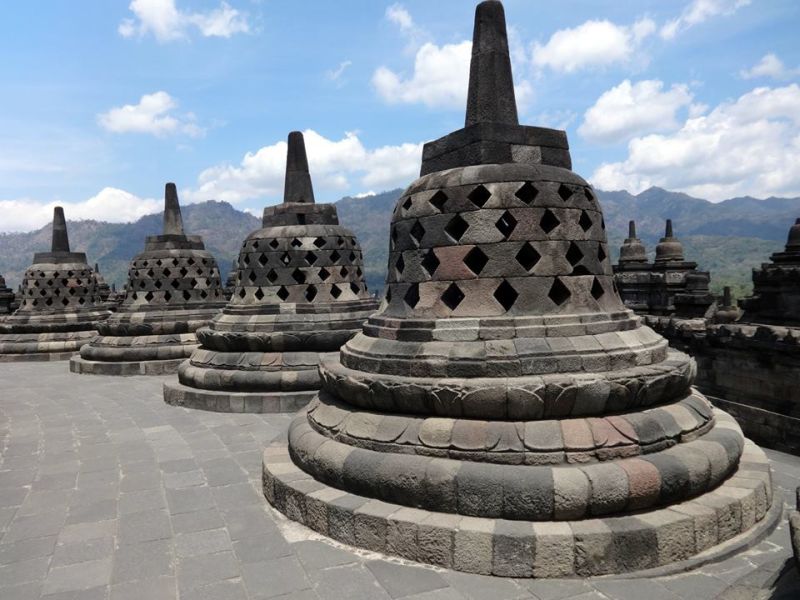
Yogyakarta
Our first stop in Indonesia was Yogyakarta. Before we left Belgium, we booked a hotel for the first night via booking.com. As we arrived in the evening in Yogya, we decided to take a taxi that brought us to our hotel. We immediately realized how friendly Indonesian people are, as our taxi driver changed the CD in his car with a CD of ‘The Beatles’, so we would feel at home.
Our hotel in Yogya was Griya Wijilan: Certainly not the cheapest hotel, but after our long flight, we were happy with the luxury of a nice, soft bed and a clean bathroom. We really could appreciate the charm of this hotel, the helpful staff and the nice breakfast in the garden of the hotel. The only thing we did not expect was the mosque right next to the hotel, meaning that we would wake up early in the morning, as prayers started at 4 am. Luckily, we had earplugs with us!
After we checked in, we were really craving for a beer and headed to the city center. We found a really nice place, where we drank our first Bintang and had our first Indonesian dinner. We got there with a becak, a nice way of transportation as you really experience the city that way. During our ride, we already had a nice view on the Kraton and passed a gathering place where you could ride with colored go carts. Matthias was immediately excited!
The main reason to visit Yogyakarta for us was the proximity of Borobudur. After our breakfast, we took a taxi for a short trip to the bus station. Just saying ‘Borobudur?’ in the bus station resulted in different persons showing us the bus where we should hop on. After a drive of one hour and a half, they dropped us on a small market, next to Borobudur.
Immediately after arriving at the small market, different becak drivers were standing in front of us, asking if we wanted to go to Borobudur. They told us that it was still far away. We took the becak without further questioning… After exactly 1 minute driving we saw the entrance. Clearly a scam. Borobudur is just a 5 minute walk from the market. Just follow the main street to the left, and you will see the entrance of Borobudur.
Did you know that in Indonesia, they use two different price rates? You have the price that Indonesian people have to pay, and you have the price that tourists have to pay. This is the case for Borobudur. Nothing to do about it, and it is still very worth it! Sometimes it feels unfair, but traveling in Indonesia is already cheap. And besides you can help this country develop and retain their cultural wonders by paying a bit more.
The park of Borobudur was smaller than we had imagined, but the temple complex itself was impressive. We took our time to explore the different floors of the complex and admired the many details. On the top floor, the “stoepas” and the view were the finishing touch of our visit. Afterwards, we strolled about the little market at Borobudur, full with kitschy souvenirs. Satisfied, and with our first souvenirs, we went back to the place the bus had dropped us off and went back to Yogyakarta. The next day, we would leave for a three day/two night tour to Bromo and Ijen.
Bromo and Ijen
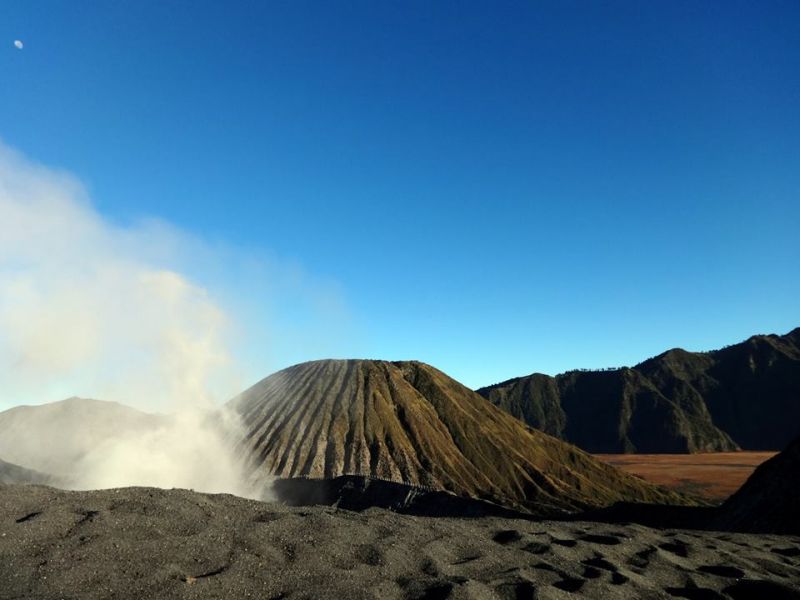
Indonesia is huge. For instance simply driving from Yogyakarta to Bromo takes up to 10 hours! Luckily, we had our e-readers and a jetlag with us. Once we arrived at Bromo, our bus dropped smaller groups of tourists to different hotels and apparently, we were in the last hotel of the day (quite basic, but at least we had a hot shower, while in other hotels, this was not the case).
The next day, we discovered that being in the last hotel is quite an advantage: the hotel where we slept was the closest to Bromo. Other tourist still had to walk for at least an hour extra, and we were almost immediately in ‘the sea of sand’ that surrounds the Bromo volcano. We choose to discover the region on foot and skipped the (more expensive) 4×4 cars. At 4 am, we started our walk to the top of Bromo, looking forward to see the sunrise on top of an active volcano.
Although we started quite early with our trip to Bromo, we really had to rush to be on time to see the sunrise. This was mainly due to the fact that we thought Bromo was another mountain than it in fact is. When walking through the sea of sand (the surrounding of Bromo), you have different mountains/volcanoes. Bromo is an active volcano, so you have to look for the smoke and walk in that direction. Then, you will pass a temple and find your way to the crater. Do not expect any help from the motorcycle drivers that are there. They are just waiting until you get lost and will then ask if you need a guide…
The view of the crater was magnificent and the sunrise was really amazing. We were really happy that we decided not to take the 4×4 tour. By doing so, we were almost alone at the top of Bromo and were already descending when the other tourist started their climb to the crater.
Once we were back at the hotel, we took a shower, had breakfast and relaxed in the sun. Around 10 am, our bus arrived to take us to the Ijen area.
After a very bumpy road, our bus managed it to get safe and sound to our hotel. Although the road and the driving behavior of our chauffeur might have looked dangerous for us Europeans, the views were spectacular. We had our first encounter with Indonesian jungle, and it looked fantastic! We cannot remember the name of our hotel, but as a lot of tourists were staying in this hotel, we suppose that there isn’t a lot of choice regarding hotels in this region. Nevertheless, the poor conditions of the hotel should not keep you away from this beautiful region. We decided to go and see the blue fire as well. We would recommend this to everyone: Ijen is the largest blue flame area in the world. You have to pay a bit more and sleep a bit less, but you definitely should see this!
To see the blue fire, it still has to be dark. The walk to the rim of the crater takes about 2 hours and then it takes 45 minutes to descent into the crater before you can see the blue fire. That means: waking up at 0.00 am! Together with a bunch of other tourists, we we’re dropped at a gather point and were introduced to our guide of the day. The guide offered us a gas mask, and we can really recommend this: As soon as you are getting closer to the top of the crater, the stronger you can smell the sulfur. At a certain moment, the sulfur grabs your breath and makes your eyes water.
During our walk down the crater, Mieke often said to Matthias: If there is a way to hell, this must be it! But all of the sudden you see why you came here and immediately forget the rest: The view of the blue fire was really breathtaking (excuses for the obvious pun). And that’s not all. At the top of the crater, a beautiful sunrise is waiting for you and the way back to the bus offer you some other spectacular views.
Did you know that Ijen is an active volcano and is an important source of sulfur? Miners carry baskets with sulfur up to the crater rim and then 3 kilometers down the mountain. A basket weighs approximately 75 – 90 kg and they do this a couple of times a day. When we saw these miners carry their baskets, and realized how little they were paid for doing this, we could not do anything else than respecting these people.
Pemuteran
After our Ijen adventure, we were ready for some sea and cocktails. The bus took us to Ketapang (Java), where we could take the ferry to Gilimanuk (Bali). We decided not to visit the most obvious places of Bali (like Kuta), but instead, we planned to focus on the upper part of Bali. We took a cheap local bus at the bus station of Gilimanuk that brought us to our first stop: Pemuteran.
At first sight, Pemuteran looks like nothing more than a street with hotels on both sides of the road, but once you take a closer look, you will love it!
After checking our travel books, we decided to stay in a hotel called ‘Jubawa’. If you arrive from Gilimanuk, the hotel is situated on the right side of the road (almost at the end of Pemuteran). We really recommend this hotel. The rooms are really beautiful, they have a nice swimming pool and the breakfast is delicious (finally, we found a place where they had banana pancakes as breakfast!). We could choose between either a room with air-conditioning or a room without (but with a fan). As we were close to the sea, the room with a fan was sufficient. After bargaining, we managed to get a room (including breakfast) for approximately 14 euro/ night.
Did you know that you ALWAYS have to haggle in Indonesia? At the beginning, we were really not good in doing this, but after a week, we got better. What we often did, was visiting different hotels or guesthouses. Then, we went back to the one we really loved and said that elsewhere, we could get a better price but we really loved their hotel. If they could give us a similar price, we would stay there. In 8 out of the 10 times, it worked.
Although we just came back from our long walk at the Ijen area, we decided to take a walk to the beach and visit a turtle rescue center that was located near the beach.
We really loved the beach of Pemuteran, as it is still very authentic and not overrun by tourists. Pemuteran is also investing in restoring the coral reef, as they have the largest Biorock coral reef nursery and restoration project worldwide. More information about this project can be found here: http://biorockbali.webs.com. Not far from this Biorock site, you have a turtle hatchery. Local people can bring eggs they found on the beach to this hatchery. Once the eggs are hatched, the little turtles stay in the hatchery for a couple of weeks and are then released. If you are lucky, you might even be able to adopt a little one and release it yourself!
Before heading back to our hotel, we met a German couple and drank a couple of cocktails together. The next day, we would leave for a snorkeling trip to Menjangan Island. A must to do in Bali!
We booked our snorkeling in the diving center next to our hotel. Our guide Surya brought us to the boat with a minivan. When we arrived at the boat, two other couples would join us that day. The boat trip itself was already really relaxing. When leaving the coast, you can see mangroves and you can see the volcanoes of Java. An amazing view! And that is only what’s above the water. After our first snorkeling hour in coral garden, we realized that also the underwater world is amazing! Our guide was amazing as he showed us many clamps, moray eels, clown fish … We loved it!
Munduk
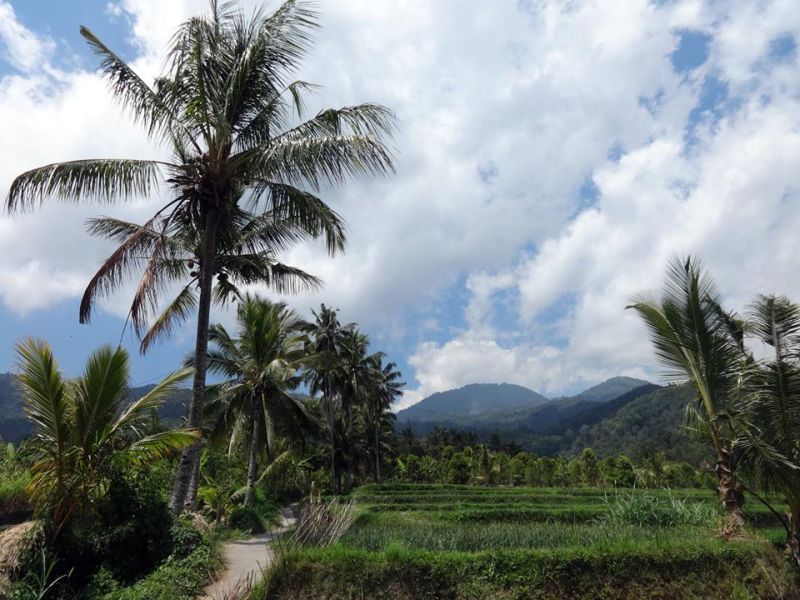
The transportation method we used to get to Munduk was a Bemo. We just stood beside the road, waiting until a Bemo would arrive. After negotiating about the price, we hopped in these minivans that are often used by local people.
The Bemo dropped us at the Puri Sunny hotel, a hotel that was not mentioned in our travel guide. As it looked charming from the outside, we decided to have a look at one of the rooms. The room itself had an outside shower, with a great view on the mountains. We also had a small balcony that looked straight into the jungle. This would become our home for the next days.
Munduk is known for its plantations: clove, vanilla, coffee, cacao …. As soon as you start walking in the area, you have the scent of clove, and you pass a lot of small shops that sell these products. Next to these plantations, Munduk also has a lot of waterfalls to offer. There are guided tours in the area, but with a map available at the hotels, you can easily do the walk by yourself. During our walk, we also passed a little bar were they sold kopi luwak.
Did you know that kopi luwak is one of the most expensive coffees in the world? The civet eats and defecates the coffee cherries. Once the cherries are defecated, they are collected, cleaned and burned, resulting in a coffee with a unique taste. Unfortunately, in recent years, the civets are kept in small cages, totally in isolation and on a strict diet, resulting in high mortality. We were not aware of this when we bought this coffee, but please, keep in mind the beautiful civets when considering buying this coffee.
The next day, we decided to rent a scooter. Near Munduk, there was a small town where you have one of the oldest banyan threes in the world. Also, the rice fields in the area of Munduk are amazing and they are easily accessible. We also met a couple of young Indonesians in a pub while they were playing on their guitar and were singing songs. We would never have imagined that Katy Perry music and rice fields were a good combination, but it was! Afterwards, we decided to drive up the mountain and after a while, we arrived at the top. Although it was quite touristic, the top offered an amazing view on two lakes in the valley.
Jatiluwih
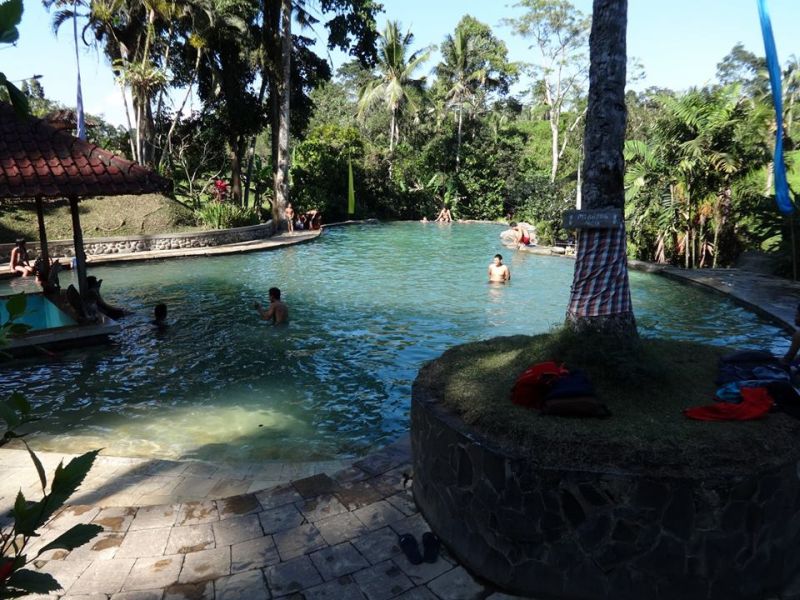
The rice fields of Munduk made us eager to see the famous rice fields in Jatiluwih. The next day, our driver would pick us up and bring us to our one and only pre-booked hotel in Jatiluwih.
Getting to Jatiluwih is not that easy. If you want to get there, you need a personal driver or you have to drive yourself, as there are no buses that drive to this place. At home, we had seen a nice tent resort in Jatiluwih via booking.com and this was one of the only hotels we booked in advance.
We stayed at the Sang Giri Mountain Resort. To be honest, we paid too much for this place. The resort had several luxurious tents in the middle of the jungle. However, after our hotel experience in Munduk, we realized that you can find rooms in Bali that are equally as beautiful and are less expensive. Besides the price, we were also disappointed about the other facilities that were mentioned on the website. And last but not least, the resort was located on a distant walk from the village and the rice fields. If you wanted to do anything in the area, you were almost obliged to book it via the resort, and the prices of these tours were extremely expensive.
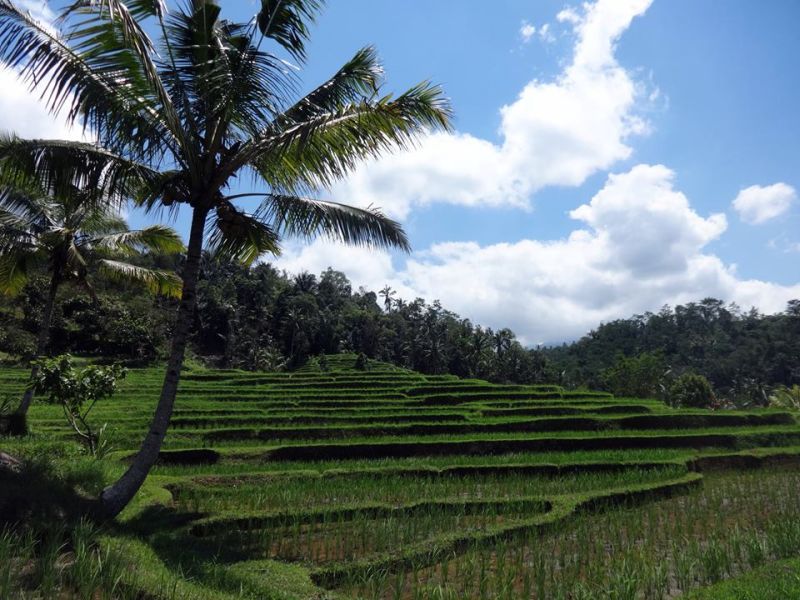
Although there are no companies that have scooters for rent in Jatiluwih, we managed to find a scooter that we could use for two days. That way, we were able to visit the area a lot cheaper than via the tours offered at our hotel. And the area of Jatiluwih is worth it. You not only have the rice terraces in the village, but also in the surrounding area, the rice terraces are worth to be protected by UNESCO. After driving through more rural areas, we arrived at a butterfly park with indigenous butterflies. We really recommend visiting the area of Jatiluwih by scooter, as there is a lot to see and the scooter offers you a lot of freedom to do this.
Another thing that we would recommend is that you should not wait too long when looking for a way to leave Jatiluwih. Leaving this place is as difficult as getting here. Just ask around in the village, and they will probably call someone or send you to someone that can help you.
Our next stop was probably the most touristic one: Ubud.
Ubud
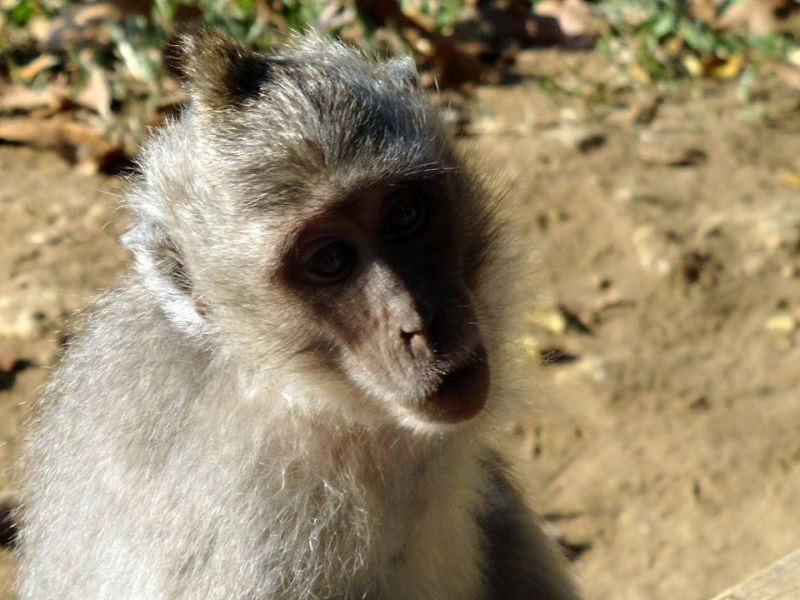
When entering Ubud, we immediately realized that this would be a more touristic place than the other places we visited in Bali. There were a lot of shops with very kitschy souvenirs. But after some time in the rural areas of Bali, the easiness of travelling in this touristic area was a welcome change.
We stayed at Semu Jaen. We managed to reduce the price of the room, which was a nice gesture of the manager. The rooms are very clean and modern, they have a swimming pool and excellent breakfast as well. Insider tip: try the home made iced fruit tea!
The first day, we visited a museum of Balinese art (Puri Lukisan) and we bought some souvenirs. In the afternoon, we visited the most famous tourist attraction of Ubud: ‘The Sacred Monkey Forest’. This park has several nice buildings and is inhabited by hundreds of macaques. Although we thought that the macaques were a bit aggressive, we did enjoy the walk through this beautiful park. In the evening, we had tickets for Balinese dancing in the palace in Ubud. The music and movements may look awkward at first. But when you pay close attention to the dancing, you really admire how much control the dancers have over their bodies.
As we stayed a day longer in Ubud than expected, we decided to go white water rafting on the Ayung river. The decor was amazing, as you felt like being in an Indiana Jones movie. If you like an adventure, go rafting in Ubud! It is still one of our best adventure experiences, next to 2 weeks in the Gobi desert and an independent hike in Mongolia.

When arriving in Ubud, we still had to decide what our next stop would be. There were two options we had in mind: The Gili Islands or Kalimatan. The first option was a very touristic choice; the other one was very adventurous. We decided to go for the adventurous option. However, due to bushfires, we had to cancel this option and in an impulsive moment, we decided that we would fly to Medan in Sumatra. From Medan, we would take a car to Bukit Lawang, where you still can admire orangutans in their natural habitat. A choice that we didn’t regret!
Bukit Lawang

To visit Bukit Lawang, we first took an inland flight to Medan. As soon as you arrive in the airport of Medan, different taxi drivers surround you, offering their services. As we arrived late in the evening, we didn’t have the possibility to take a local bus. The trip to Bukit Lawang still takes two hours and the road is rather bumpy.
Jungle treks are the most popular and best thing to do in Bukit Lawang. However to do this, you will need a guide. Don’t be afraid that it will be difficult to find one, because as soon as you arrive in Bukit Lawang, different guides are waiting for you to introduce themselves. If you are looking for a guide in Bukit Lawang, make sure that you have a connection with the guide and also make sure that the group for the trek will not be larger than 5 persons.
Our hotel in Bukit Lawang was the Jungle Inn. You can find it at the end of the village. It is a 20 minute walk from the bus stop. But we definitely recommend this place. The rooms are really neat and the restaurant is a really enjoyable place to eat and have a drink in the evening. Every evening, there is also a little performance of the staff, where they sing the famous Bukit Lawang song: a song that will be in your head for a couple of days! The staff is extremely friendly as well! We loved this place!
The next day, we were ready for a meeting with the orangutans! We decided to do a jungle trek for only one day. We did however choose for the tubing afterwards. If you do the jungle trek, you should do the tubing as well! We left with a group of five and two guides. You need a good condition to do the jungle trek as you have to climb and descent a lot. Also take enough water with you, because the environment of the jungle makes you sweat a lot. A lot! In total, we saw about 9 orangutans, including the small ones and a male version (really impressive!). We also saw a pig tail macaque, Thomas leaf monkeys, gibbons … At noon we had a delicious lunch in the jungle. What a day!
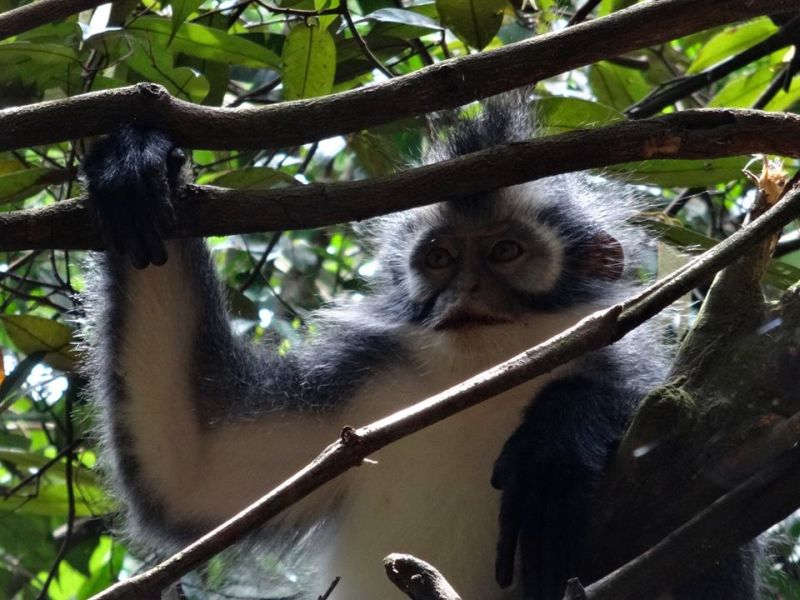
At the end of the trek, we arrived at the river that goes back to the village. After a sweaty day, we were really happy to go in the fresh water, enjoying the amazing jungle views. Meanwhile, our guides were preparing ‘the tubing boat’ that would bring us back to Bukit Lawang. The boat consisted of different inner tubes of trucks, bound together. That boat took us back to the village, while our guides tried to take as many rapids as possible. Fun guaranteed!
Do you know Mina? Everyone who has ever been in Bukit Lawang knows Mina. She is probably the most famous orangutan of this area. But don’t get us wrong: This is not the orangutan that you want to meet in the jungle. She is the Queen of the Jungle, and is defending this status with aggressive behavior. On the internet, you can find a lot of stories about Mina and some are really showing her aggressive behavior. When you go in the jungle, don’t be afraid. Always keep in mind: these animals are not pets. Also, don’t feed these animals, it makes them even more aggressive. So please, don’t do this, and also ask your guide not to feed the animals.
Bukit Lawang also has a bat cave. We decided to do this on our own, but at the entrance of the cave, there was a guide that insisted that we should rely on his services. And luckily, we did this, because we wouldn’t have seen a lot of the cave if it wasn’t for him. It was already quite late when we arrived at the cave, and the bats were already flying around, making it even more impressive. One hint: Don’t go inside if you are afraid of big spiders! Another hint: If you really like this type of animals, there is a cave with big spiders and even cobras. We decided to skip that cave…
Extra: if you like wildlife alot than Sri Lanka should be high on your list: Complete travel guide on how to travel in sri lanka
Banda Aceh and Pulau weh
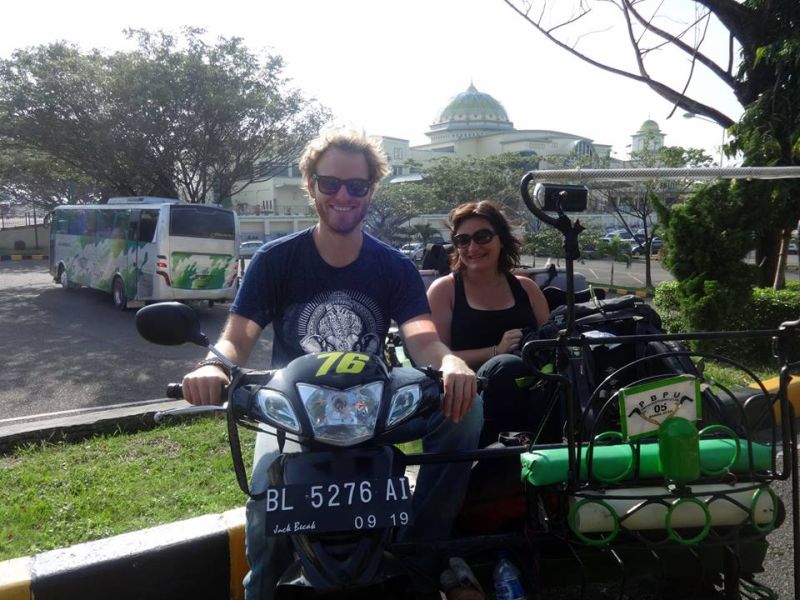
One of our final stops was Banda Aceh. To be honest, we are not sure how to describe this city. We did not feel welcome in this city, so this might distort our perception. First thing that we did when arriving in Banda Aceh was looking for a hotel. In the first hotel, a nice lady showed us the price for the room, when all of the sudden her superior came to her, saying that all rooms were full. Apparently, we were not welcome. In the second hotel, the same thing happened. We had more luck in the third hotel, but they were still not keen on us. Acehnese people are not used to see a lot of Western people: everyone stared at us when we walked on the street.
To remember what happened in 2004, the people of Banda Acheh build a tsunami museum. The museum itself is very impressive. It really shows the destruction the tsunami made to this region. For us, the most intriguing was the first part of the museum where you enter a narrow long tunnel that represent how high the waves of the tsunami were. Afterwards, we visited boats that the tsunami carried inland.
Our final stop was on the tropical island ‘Weh’. To get there you can take a ferry from Band Aceh. We were lucky that day, because all of the sudden, a group of dolphins were swimming next to the ferry. The people on the boat said they were welcoming us, a thing that we really liked to believe.
Pulau Weh is famous for its laidback atmosphere and its amazing places for scuba diving and snorkeling. Iboih is the best place for snorkeling so we decided to look for a hotel over there.
We stayed in one of the Yulia’s bungalows. You can easily find this place: it is at the end of the jungle path, the last hotel in town. Yulia’s has different types of bungalows, but we loved the ones with the sea views. Do not expect a lot of luxury, but the views itself make this experience priceless. At Yulia’s, you also have a nice restaurant with an amazing view.
Pulau Weh has a laidback atmosphere, and you should really take your time to visit this island. Unfortunately, we only had 1.5 days left. We decided to snorkel and rented a canoe to cross the sea to the little island Rubiah. When you cross the island, you arrive at sea garden, a really nice spot to snorkel.
Pulau Weh was a really nice place to say goodbye to Indonesia. Maybe even more because ‘Weh’ means ‘go away’ in Achenese.
Want to see more usefull information about Asia? Check out our travel guides below:
Cambodia: The ultimate country guide to travel in Cambodia + itinerary
China: Indepth Hong Kong travel guide for a 4 days city trip
Sri Lanka: Everything you need to know on how to rent a tuktuk in Sri Lanka